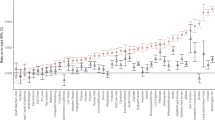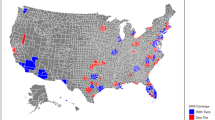Abstract
Previous research has established a need for operations research models to help urban public housing authorities (PHAs) in the U.S. better manage the transition from the traditional model of high-rise public housing developments to tenant-based housing subsidies for market-rate rental units and project-based housing subsidies for scattered-site, low-density public housing. This paper presents the tenant-based subsidized housing location model (TSHLP) that is simplified and applied to a larger and more representative data set than has been done previously. Base-case and sensitivity analyses indicate that model solutions, which are approximations to a Pareto frontier of nondominated potential family allocations, give planners considerable flexibility in choosing alternative housing configurations that can satisfy the needs of various interest groups.
Similar content being viewed by others
References
Chicago Housing Authority. (1998). Dataset of Observations of Public Housing Residents. Chicago.
Cohon, J.L. (1978). Multi-Objective Programming and Planning. New York: Academic Press.
Environmental Sciences Research Institute. (1996). “ArcView GIS Version 3.0a.” Redlands, CA.
Erkut, E. and S. Neuman. (1992). “A Multi-Objective Model for Locating Undesirable Facilities.” Annals of Operations Research 40, 209–227.
Forgionne, G.A. (1991). “HANS: A Decision Support System for Military Housing Managers.” Interfaces 21(6), 37–51.
Forgionne, G.A. and Y.S. Frager. (1998). “The US Army Relies on Decision Support Systems in Allocating Housing Resources.” Interfaces 28(2), 72–79.
Freeman, L. and W. Rohe. (2000). “Subsidized Housing and Neighborhood Racial Transition: An Empirical Investigation.” Housing Policy Debate 11(1), 67–89.
Galster, G.C. (2002). “An Economic Efficiency Analysis of Deconcentrating Poverty Populations.” Journal of Housing Economics 11(4), 303–329.
Galster, G.C., Tatian, P., and R. Smith. (1999). “The Impact of Neighbors Who Use Section 8 Certificates on Property Values.” Housing Policy Debate 10(4), 879–917.
Galster, G.C. and A. Zobel. (1998). “Will Subsidized Housing Programmes Reduce Social Problems in the US?” Housing Studies 13(5), 605–622.
Housing Authority of Cook County. (1998). Dataset of Families in Tenant-Based Section 8 Housing in Suburban Cook County.
Ibaraki, T. and N. Katoh. (1988). Resource Allocation Problems: Algorithmic Approaches. Cambridge, MA: The MIT Press.
ILOG-CPLEX Division. (1998a). AMPL Plus Version 1.50. Distributed by Compass Modeling Solutions, Incline Village, NV.
ILOG-CPLEX Division. (1998b). CPLEX5.0 for AMPL Plus. Distributed by CompassModeling Solutions, Incline Village, NV.
Johnson, M.P. (1997). “An OptimizationModel for Location of Subsidized Housing inMetropolitan Areas.” Unpublished Dissertation. Evanston, IL: Northwestern University.
Johnson, M.P. (2000). “The Role of Quantitative Planning Techniques in the Redesign of Subsidized Housing Policy.” In H.L. White and M.P. Johnson (eds.), Housing and Sustainable Community Development: Enhancing Minority Home Ownership, Vol. 1. Pittsburgh: COMPA, pp. 69–83.
Johnson, M.P. (2001). “Tenant-Based Subsidized Housing Location Planning under Uncertainty.” Socio-Economic Planning Sciences 35(3), 149–173.
Johnson, M.P. (2002a). “Single-Period Location Models for Subsidized Housing: Project-Based Subsidies.” Heinz School Working Paper Series, 2002–44. WWW: http://www.heinz.cmu.edu/ wpapers/detail.jsp?id=4315. Accessed 05/03/03. Under review at Socio-Economic Planning Sciences.
Johnson, M.P. (2002b). “Decision Support for Family Relocation Decisions under the Section 8 Housing Assistance Program Using GIS and the Analytic Hierarchy Process.” Journal of Housing Research 12(2), 277–306.
Johnson, M.P. (2003). “Nonlinear Models for Housing Mobility Program Planning.” Heinz SchoolWorking Paper Series, 2000–22. WWW: http://www.heinz.cmu.edu/wpapers/detail.jsp?id= 178. Accessed 05/03/03. Under review at Operations Research.
Johnson, M.P. and A.P. Hurter. (1998). “An Optimization Model for Location of Subsidized Housing in Metropolitan Areas.” Location Science 6, 257–279.
Johnson, M.P. and A.P. Hurter. (1999). “Economic Impacts of Subsidized Housing Relocation.” Papers of the Regional Science Association 78(3), 265–295.
Johnson, M.P. and A.P. Hurter. (2000). “Decision Support for a Housing Relocation Program Using a Multi-Objective Optimization Model.” Management Science 46(12), 1569–1584.
Johnson, M.P., H.F. Ladd, and J. Ludwig. (2001). “The Benefits and Costs of Residential-Mobility Programs for the Poor.” Housing Studies 17(1), 125–138.
Kaplan, E.H. (1986). “Tenant Assignment Models.” Operations Research 34(6), 832–843.
Kaplan, E.H. and O. Berman. (1988). “OR Hits the Heights: Relocation Planning at the Orient Heights Housing Project.” Interfaces 18(6), 14–22.
Kuby, M.J. (1987). “Programming Models for Facility Dispersion: The p-Dispersion and Maxisum Dispersion Problems.” Geographical Analysis 19(4), 315–329.
Marsh, M.T. and D.A. Schilling. (1994). “Equity Measurement in Facility Location Analysis: A Review and Framework.” European Journal of Operations Research 74, 1–17.
Martin, C.A., M.P. Johnson, and W.M. Williams Foster. (2000). Analysis of Impediments to Fair Housing Choice in the City of Pittsburgh, Pennsylvania. Pittsburgh: The City of Pittsburgh Department of City Planning.
Miettinen, K.M. (1999). Nonlinear Multiobjective Optimization. Boston: Kluwer Academic.
Miles, M.E., R.L. Haney, Jr., and G. Berens. (1996). Real Estate Development: Principles and Process, 2nd ed. Washington, DC: Urban Land Institute.
Murray, A.T., R.L. Church, R.A. Gerrard, and W.-S. Tsui. (1998). “Impact Models for Siting Undesirable Facilities.” Papers in Regional Science 77(1), 19–36.
Quercia, R.G. and G.C. Galster. (1997). “The Challenges Facing Public Housing Authorities in a Brave New World.” Housing Policy Debate 8(3), 535–569.
Ratick, S.J. and A.L. White. (1988). “A Risk-Sharing Model for Locating Noxious Facilities.” Environment and Planning B 15, 165–179.
Rosenbaum, J.E. (1995). “Changing the Geography of Opportunity by Expanding Residential Choice: Lessons from the Gautreaux Program.” Housing Policy Debate 6(1), 231–267.
Turner, M.A., S. Popkin, and M. Cunningham. (1999). “Section 8 Mobility and Neighborhood Health: Emerging Issues and Policy Challenges.” Washington, DC: The Urban Institute. WWW: http:// www.urban.org/UploadedPDF/sec8∖_mobility.pdf. Accessed 05/03/03.
U.S. Department of Commerce. Economics and Statistics Administration. (1990a). Census of Population and Housing: Summary Tape File 3A, 1990: Illinois [Adams County –Cook County] [CD 90–3A-16] [CD-ROM]. Washington, DC: Bureau of the Census.
U.S. Department of Commerce. Economics and Statistics Administration. (1990b). Census of Population and Housing: Summary Tape File 4, 1990 [Mainframe tape]. Washington, DC: Bureau of the Census.
U.S. Department of Commerce. Economics and Statistics Administration. (1991). American Housing Survey, Chicago Metropolitan Area, 1991: [Compact Disk]. Washington, DC: Bureau of the Census.
U.S. Department of Housing and Urban Development. (1998). A Picture of Subsidized Households –1998. WWW: http://www.huduser.org/datasets/assthsg/statedata98/index.html. Office of Policy Development and Research. Accessed 05/03/03.
U.S. Department of Housing and Urban Development. (1999). Moving to Opportunity for Fair Housing Demonstration Program: Current Status and Initial Findings. Washington, DC: Office of Policy Development and Research. WWW: http://www.huduser.org/publications/fairhsg/mto.html. Accessed 5/3/03.
U.S. Department of Housing and Urban Development. (2000). “Voucher Recipients Enjoy Much Greater Choice About Where to Live than Residents of Public Housing and Are Less Likely to be Concentrated in Distressed Neighborhoods.” Issue Brief No. 1. Washington, DC: Office of Policy Development and Research. WWW: http://www.huduser.org/publications/pdf/voucher.pdf. Accessed 05/03/03.
U.S. Department of Housing and Urban Development. (2001a). Housing Choice Voucher Program Fact Sheet. WWW: http://www.hud.gov/offices/pih/programs/hcv/index.cfm. Accessed 05/03/03.
U.S. Department of Housing and Urban Development. (2001b). Fair Market Rent History 1983–Present. Washington, DC: Office of Policy Development and Research. WWW: http://www.huduser.org/datasets/fmr/histread.html. Accessed 05/03/03.
U.S. Department of Transportation. Federal Highway Administration. (1998). Welfare Reform and Access to Jobs in Boston. BTS98-A-02. Prepared by A. Lacombe. Washington, DC: Bureau of Transportation Statistics.
Author information
Authors and Affiliations
Rights and permissions
About this article
Cite this article
Johnson, M.P. Single-Period Location Models for Subsidized Housing: Tenant-Based Subsidies. Annals of Operations Research 123, 105–124 (2003). https://doi.org/10.1023/A:1026119128524
Issue Date:
DOI: https://doi.org/10.1023/A:1026119128524




